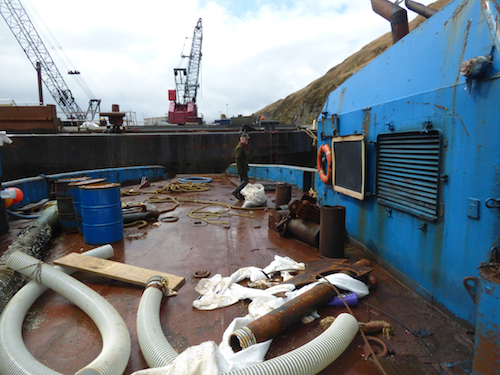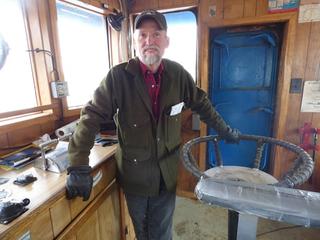M/V Redeemer Heads for Scuttling, After Decades of Salvage Work

Wednesday, May 13 2015
A legendary Western Alaska salvage vessel has reached the end of its life. Salvager Dan Magone is getting ready to sink his old tugboat, the Redeemer.
And as KUCB’s Annie Ropeik reports, it means he’s also getting ready for the next phase of his own storied career.
These days, even getting onto the Redeemer is a bit of an adventure. The tug is separated from the dock in Dutch Harbor by two other Dan Magone projects -- old vessels in disrepair.
Magone: Oh, I guess the only place to cross is right here…
Magone is finding a tricky path out to the boat where he built his career. The Redeemer had its last mission in 2013, when the crab boat Arctic Hunter went aground outside Unalaska.
Now, the tug is past its prime. It’s littered with remnants of old jobs – wood pallets, rusty scrap metal, an old National Geographic in the wheelhouse – all waiting for a proper send-off.
"I spent a lot of the last 25 years on this boat," Magone says up in the wheelhouse. "Lots of days and nights, lots of adventures."

The Redeemer at sea during the salvaging of the M/V Cougar Ace in 2006. (Charles Homans/KUCB)
The Redeemer was built in WWII, then became an oil drilling mud-ship off the Gulf Coast. In the 1980s, Magone says a company heading to the Nome gold fields took it on. They wrecked it on the sand dunes there, and it stayed put for almost a decade.
"During that time, I saw it over there and people suggested it’d make a great boat for me," Magone says. "I told them no -- it would probably cost me $100-grand to get it off the sand dunes and get it to Dutch."
Instead, he says the boat wound up with loggers from Sitka. They patched it up and headed south, but wound up abandoning the ship in Sand Point.
"And then it sank at the dock," he says, laughing. "Everywhere it goes it’s leaving people with their head in their hands, right?"
Meanwhile, Magone had just paid millions to set up his floating Dutch Harbor office, and was losing local business to shorter fishing seasons. He saw a new opportunity in the stranded boat. He rebuilt it for cheap, with scraps from his own yard. The yellow-green hull was painted a bright blue, and Magone renamed the boat Redeemer.
He says its first job was hauling horses, dogs, hay and cowboys to the other side of Unalaska Island to start the Chernofski cattle ranch.
"And so we did all manner of anything, all over the Bering Sea and the Aleutian Islands, Alaska Peninsula, and we managed to survive," he says. "We managed to find enough work to keep going."
Over the next two decades, he says the Redeemer was part of "almost every significant salvage job in Western Alaska," from the small, like stranded barges and fishing boats, to the huge: deadly groundings and oil spills on the M/V Kuroshima and Selendang cargo ships, and the capsizing of M/V Cougar Ace, a car carrier.
All those accidents – plus the Exxon Valdez spill – helped usher in new environmental protection and safety standards. By 2013, Magone says the Redeemer couldn’t keep up – and work on its replacement was just as pricey.
"It eventually cost so much that I just had to sell the company," he says. That sale to Resolve Marine International went through last year. And the Redeemer has been taking up valuable space in their new shop.
Shipping it out as scrap isn’t cost-effective – so Magone is asking the federal government for permission to scuttle the boat. He says that’ll mean cleaning it out, setting up explosives and sinking it at mile-deep spot north of Unalaska Island, where he's been allowed to sink ships in the past.
"See all this equipment, the winches and the cranes, all the hydraulic lines and stuff? That all comes off," he says, pointing around the Redeemer's deck. "There can’t be any loose debris in or on the boat. So there’s a great big bunch of work to do."

Dan Magone crosses the deck of the salvage vessel Redeemer. (Annie Ropeik/KUCB)
Increasing regulations have made scuttling harder, too, but Magone is confident this one will happen in the next couple of months. He’s already taken the ship’s bell from the wheelhouse.
"Otherwise, it’s just another piece of metal that might be worth something to someone," he says. "But that one – I don’t want to sell."
His new work boat, the Makushin Bay, is visible outside the window -- built for the future, but the same blue as the Redeemer. Magone says it marks the start of a new era, and the Redeemer’s scuttling will be the end of another.
"The old days, the seat-of-your-pants, the 'just go out and git-er-done' type of thing -- those days are gone," he says. "With all the regulations and oversight and everything, it’s not the world that we were able to operate in.
"That world is past now," he says -- the world where he was a cowboy, too, like the ones he once took for a ride on the Redeemer.



